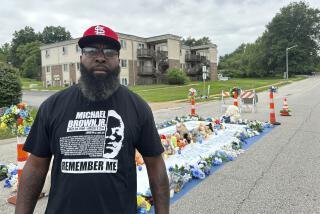Black residents in Florida city say they’re often harassed by police
Reporting from Sanford, Fla. — The slaying of Trayvon Martin, an unarmed, black 17-year-old, by a neighborhood watch volunteer has prompted a federal investigation and, on Thursday, the temporary ouster of the city’s police chief.
To many black residents of Sanford, the escalating national anger over how local police have handled the case reflects years of tension and frustration over their treatment by authorities.
Murray Jess, for one, can’t shake the memory of an evening two years ago, as he drove through Sanford at dusk, heading home after attending an art show with his fiance and his 14-year-old nephew.
A police cruiser began following Jess’ silver-gray 1996 Mercedes. Two unmarked police cars blocked the road in front of him, forcing Jess into a Pizza Hut parking lot. An officer got out of a van and pointed a video camera at the bewildered Jess as another officer, his hand on his gun, approached the car.
Jess asked the officer why he had been stopped. “He said, ‘We’ve had a lot of reports of these kinds of cars being stolen lately,’ ” said Jess, a black Sanford resident and business owner whose voice still shakes with rage.
On Thursday evening, Florida Gov. Rick Scott and Atty. Gen. Pam Bondi appointed a special prosecutor to investigate Martin’s shooting, removing the state attorney who had been considering the case.
Earlier in the day, Police Chief Bill Lee Jr. bowed to pressure and stepped down “temporarily,” but neither he nor City Manager Norton N. Bonaparte Jr. explained when or whether he might return to the job. And Lee’s move did not appear to quell the anger over Martin’s death or over the police department’s decision not to arrest George Zimmerman, the man who said he shot the teen.
“Since the chief has stepped down, it’s a temporary relief, but we need a permanent relief,” Martin’s stricken-looking mother, Sybrina Fulton, said Thursday at a news conference in downtown Sanford, where hundreds gathered in anticipation of a rally later to be led by theRev. Al Sharpton.
“I still say we need an arrest,” Fulton said as shouts of “We want an arrest!” floated from the crowd.
“We want an arrest, we want a conviction, and we want him sentenced for the murder of our son,” said Martin’s father, Tracy Martin.
Zimmerman, a neighborhood watch volunteer, has said he fired in self-defense; Trayvon’s family says Zimmerman targeted the teen because of his skin color, and they say the police department has given Zimmerman a pass because he is not black.
Police counter that Florida’s so-called stand your ground law, which gives people wide latitude to use deadly force if they feel threatened, makes it difficult to arrest Zimmerman despite conflicting accounts of the moments leading up to the shooting.
The result is a city gripped by rage and frustration, and led by officials mortified at the national spotlight being shone on their waterfront community.
Public anger boiled over at a city commissioners meeting Wednesday night, where blacks recounted stories similar to Jess’, and where whites described their embarrassment at living in Sanford, a city of about 55,000 people 25 miles from Orlando.
“I’m ashamed to call this my home,” said David Ortman, who is white and whose comments brought a burst of applause from the audience.
Jess told his story at the meeting and repeated it Thursday in his Jess Dental Lab in Sanford’s historic downtown. His seething demeanor belied the placid atmosphere on the streets outside, where Victorian homes with broad porches line streets shaded by giant oaks dripping with Spanish moss. At lunchtime, people stroll or jog along the promenade skirting Lake Monroe while others relax in lawn chairs, fishing poles dangling over the water.
Sanford was incorporated in 1877, and in 1891 the black community of Goldsboro became part of Sanford. Its downtown residential district is on the National Register of Historic Places. The riverfront walk, designed to draw more visitors to the city, was completed in 2004.
Outside of downtown, the racially mixed city resembles a lot of other sprawling Florida communities, with strip malls, wide avenues and gated communities of modern housing complexes similar to the one where Martin was shot.
At the housing complex Thursday, on a quiet street a few miles from downtown, a memorial of balloons, stuffed animals and signs calling for justice drew a stream of visitors.
Just blocks from the waterfront, though, police were bracing for thousands of people to attend the Sharpton rally. And a newly scrutinized audio of Zimmerman’s phone conversation with a 911 operator on Feb. 26, as he followed Martin, indicated he had used a racial slur. That would undermine statements of Zimmerman’s father, who has described his 28-year-old son as a Latino with no racial biases.
Critics of the police department say its handling of the Martin case is hauntingly similar to another case last year, when Sherman Ware, a 28-year-old black man, was punched from behind by a white man, who was the son of a police lieutenant. The attack was captured on video and posted on YouTube, but the assailant was not immediately arrested. That incident forced out the previous police chief, and Lee took over in May 2011.
His defenders said 10 months wasn’t enough time to turn things around. “There are two sides to every story,” said Glen Denman, a white Sanford resident. “All I’m saying is this has to run its course.… We can’t rush to judgment and have Chief Lee be responsible for everything that occurs.”
But Jess and others say for every high-profile case like Ware’s and Martin’s, there are many more that are never publicized.
“This place has a history,” Jess said as his friend, Jack Jackson Sr., nodded in agreement and told his own stories of being followed by police cruisers and pulled over for no reason or on trumped-up allegations of suspicious behavior.
One night, Jackson said, he was followed all the way to his driveway by police, who trailed him from his church where he had helped clean up after a fish sale. In another incident, he said, police blocked the road in front of him and told him to “shut up” when he asked why he was being stopped.
“If you’re out after 12 o’clock and you’re black, you’re gonna get either shot or beat up,” Jackson said.
Robin Riggins, who is black, recalled an encounter five years ago, when a police cruiser began trailing her one night, cutting off a truck to prevent it from getting between Riggins’ vehicle and the police car. “He was just really threatening me at the time,” Riggins said of the officer, whom she described as approaching her with his hand on his gun. “I asked him to please calm down and step away from the car.”
The reason for the pullover was an alleged tag violation. When Riggins complained to police later about what she considered racial profiling, she was told it could not have been racial profiling because her car’s windows were tinted and the police couldn’t see that she was black.
“My windows were not tinted then, and they’re not tinted now,” Riggins said.
Among other things, Martin’s killing has sparked debate on the wisdom of the stand your ground law, which exists in varying forms in 20 other states.
Jackson scoffed at the idea that the outrage over Martin’s slaying would bring change to Sanford or to any other place with a history of racial profiling. “If you black, you black,” he said.
Jess also was skeptical, but he said he would rather fight the system than leave Sanford. “It’s a slow change, but you have to force the change,” he said, adding that he sensed a growing willingness of people to challenge a mind-set that he says is stuck in another era.
“I think people are getting more strength now to deal with it,” Jess said. “They’re not as afraid as they used to be.”
Susan Jacobson of the Orlando Sentinel contributed to this report.
More to Read
Sign up for Essential California
The most important California stories and recommendations in your inbox every morning.
You may occasionally receive promotional content from the Los Angeles Times.











